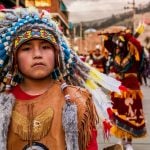Plateau Indian Cradleboards (Photo Diary)
As Grandmother Taught: Women, Tradition and Plateau Art was a special exhibit at the Northwest Museum of Arts and Culture in Spokane, Washington. The exhibit featured several Plateau cradleboards.
 The Indian nations of the Columbia River Plateau are shown above.
The Indian nations of the Columbia River Plateau are shown above.
Cradleboards allowed infants to be carried easily and safely. They also allowed the mother’s hands to be free for other tasks. In his Encyclopedia of North American Indians, Frederick Hoxie writes:
“Psychologically, a baby in a cradleboard feels safe and secure; he or she is swaddled and held close to the mother. Cradleboards are objects of beauty and are a personal expression of the maker. Depending on the tribe, they can be decorated with beadwork, quillwork, weaving, woodwork, and/or ribbon and cloth designs. Cradleboards may also be decorated or designed with sacred symbols, colors, or objects to bring good life and luck to the child.”
In the Plateau Culture Area, babies were generally placed in cradleboards soon after birth. A line attached to both sides of the upper end of the cradleboard allowed the the infant to be carried on the back or, when on horseback, on the pommel of a saddle. When the mother was working, the cradleboard could be hung in a tree where it could gently sway with the wind.
With regard to the Northern Okanagan, Lakes, and Colville tribes, Dorothy Kennedy and Randal Bouchard, in their chapter in the Handbook of North American Indians, report:
“For the first few months, a child spent most hours fastened to a cradleboard.”
Depending on tribal traditions, an infant might use the cradleboard for just a few months or until two or three years of age. Among the Yakama, for example, the infant would continue to be carried in the cradleboard for two or three years, with a new cradleboard being made as the child grew.
Among many of the tribes, cradleboards would be decorated with beads and were regarded as heirlooms to be used for several generations. In other tribes, a new cradleboard was made for each child and then discarded when no longer needed.
In some tribes, there were no differences between the cradleboards used for boys and those used for girls, while in other tribes there were some slight differences. With regard to the Middle Columbian Salishans, Jay Miller, in his chapter in Handbook of North American Indians, reports:
“Slight differences marked male or female cradleboards and bindings, in addition to the kinds of dangles hung from the protecting head loop. For a boy, the penis was exposed, while a girl had a buckskin fold between her legs to allow urine to run off.”


 Shown above is a cradle board made by Bernadine Phillips (Colville Reservation)
Shown above is a cradle board made by Bernadine Phillips (Colville Reservation)  Shown above is a cradle board made by Bernadine Phillips (Colville Reservation)
Shown above is a cradle board made by Bernadine Phillips (Colville Reservation)  Shown above is a Nez Perce cradle board.
Shown above is a Nez Perce cradle board.  Shown above is a cradle board made by HollyAnna Cougar Tracks DeCoteau Little Bull.
Shown above is a cradle board made by HollyAnna Cougar Tracks DeCoteau Little Bull.  Shown above are two cradle boards made by Leanne Campbell.
Shown above are two cradle boards made by Leanne Campbell.  Shown above is the detail of the beading.
Shown above is the detail of the beading.  Shown above is the detail of the beading.
Shown above is the detail of the beading.  Shown above is the detail of the beading.
Shown above is the detail of the beading.  Shown above are Nez Perce cradle boards.
Shown above are Nez Perce cradle boards.  Shown above is the detail of the Nez Perce beading.
Shown above is the detail of the Nez Perce beading.  Shown above is the detail of the Nez Perce beading.
Shown above is the detail of the Nez Perce beading.  Shown above is a Nez Perce toy cradle board.
Shown above is a Nez Perce toy cradle board.




